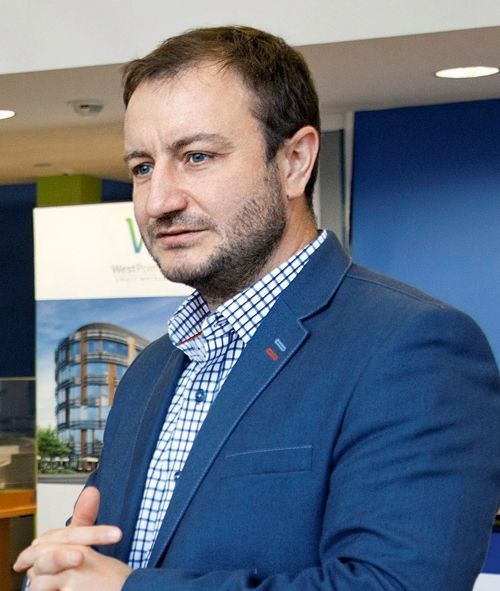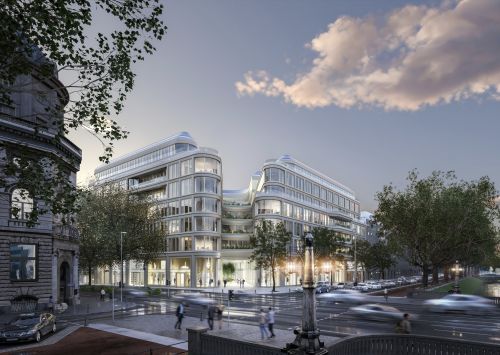A good tailor needed
Office & mixed-use development
Let’s start with defining the concept – what exactly is a built-to-suit office? The issue is significant because many developers use the BTS abbreviation and, as it turns out, it could mean something different to each of them. Marketing departments often overuse the BTS concept and basically offer traditional office projects that do not possess features designed specifically for their clients’ requirements. “Such a tenant enters a building which (in the best case) is at the shell & core stage. So they are able to decide about the layout of the floors, the lighting, the furniture and the interior design, and that is actually all,” says Łukasz Paryś, the director of operations for office projects at Bouygues Immobilier Polska. “The majority of tenants are satisfied with that. However, they will not be able to change, for example, the location of bathrooms or the server room. They will not be able to build internal stairs between floors or extend the floor areas. If they opt for all that, it will involve much greater costs than for a planned development. The costs will of course have to be covered by the tenant, but maybe not directly– they might be hidden in shorter rent holidays.
A difficult birth
The first spectacular BTS office project in Poland was Miasteczko Orange, the construction of which started in Warsaw’s Ochota district at the beginning of 2011 and took almost 2.5 years. Bouygues Immobilier Polska built a useable area of almost 44,000 sqm for the telecommunication giant (the general contractor was Karmar). “Miasteczko Orange involved a complete change in the tenant’s work organisation,” explains Łukasz Paryś of Bouygues Immobilier Polska. “The company was leaving its office in the city centre [the office building on ul. Twarda, now called Spektrum – editor’s note], which was mostly divided into small rooms and long, narrow corridors. The new location was meant to bring the employees together in a shared space, to streamline the cooperation and communication among them. Thus it was clear from the outset that Orange’s new home had to be built outside the city centre, with open space and a floor plate of around 10,000 sqm. We suggested three locations to the company and Orange chose the Al. Jerozolimskie corridor. The entire process took just under four years, including the construction process, which, due to its scale, took around 27 months. Obviously, such a process can be completed within a reasonable period – even in the case of a very demanding client.
The typical client
Is there a universal profile for clients interested in built-to-suit offices? A typical BTS office building client is a large enterprise or group that wants to build an HQ that will often service an entire region. Such a company employs more than 1,000 people and needs a minimum of around 10,000–20,000 sqm. The consolidation of offices from a number of locations is often the main goal of the project,” claims Łukasz Paryś. However, smaller BTS projects are being developed more and more often in regional markets and for tenants considerably less familiar than Orange. Such boutique projects include a building on al. Roździeńskiego in the inner centre of Katowice that was completed in April by local company Brema. The six-storey building with just over 6,000 sqm of office and service space is a joint concept of the developer and IT company BPSC (Biuro Projektowania Systemów Cyfrowych). The company is also the anchor tenant of the building, occupying three out of the six floors. “BPSC had been looking for offices in Katowice that would meet its requirements for many months, but could find nothing that fulfilled them,” relates Michał Dobrowolski, the managing director of Brema. “So we decided to develop an office building precisely designed for the company’s specified needs. The priority was an economic construction process, a central location and a good address, as well as amenities for employees, such as public transport links, connection roads to satellite towns and having shops nearby,” he adds. BPSC’s staff will also be able to use a terrace on the roof and green relaxation areas around the building. Another tenant, furniture company MDD, is to move into the building soon and will open a showroom in the building. The remaining office space of 2,500 sqm at this address is to be leased out on the open market.
Cheap class ‘A’ square metres
The view that BTS office buildings are expensive, exclusive projects for the chosen few is false, according to many developers operating in this segment of the market. “The tenant decides on many of the features at the design stage, such as how much the developer will spend on purchasing the plot, what installations and furnishing there will be in the building, whether the façade be made of marble or polished concrete, and so on,” says Łukasz Paryś, before adding: “In other words: the tenant can decide whether they will pay EUR 8, 12 or 14 per sqm in the future.”
Katowice-based developer Brema has managed to combine quality, modern technology and cost efficiency. “Independent IT, ICT and heating systems were installed on each of the floors. This made it possible for us to deliver a high standard and quality to the building on the one hand, and on the other such systems provide tenants with savings. As a result we can now offer low operating costs, which translates into attractive rental terms,” comments Michał Dobrowolski. The starting rent in the Brema office building is EUR 12.5 per sqm, while the operating fee is app. EUR 3 per sqm.
Whose money and whose risk?
One attractive feature of BTS projects for the tenant is the fact that the building has been developed especially for them but the developer is responsible for the business risk of the project. “Of course we sign a prelease contract before the purchase of the plot, as this secures our interest since after the completion of the building it remains our property – unless the tenant is planning to buy the building after the project’s completion. Then we can consider other forms of cooperation,” explains Łukasz Paryś. “We sign a long-term contract with the tenant and this is secured with a surety or a bank guarantee. Banks look favourably at such cooperation, particularly if your partner has a good standing,” says Michał Dobrowolski of Brema. “We ourselves do not use bank financing, but I know that banks are eager to finance such projects,” admits Łukasz Paryś.
Bartek Włodarski, the director of the tenant representation department at Knight Frank, believes that a BTS office could be attractive for investors as a product with long-term rates of return. “In Poland you can sign leases for a maximum of 30 years and tenants who opt for a built-to-suit office usually have long-term plans for it,” he explains.
Home, sweet home
“We work with a BTS client from the very beginning of a project, from the first page of the design brief,” says Łukasz Paryś. “We start with getting to know the preferred location and its surroundings, then we plan the details of the office space – the number of departments in the company, the number of people who will work there, the methods of communication, whether the employees are to work in open space or in smaller rooms, and so on. We help them to understand the role of space in terms of efficiency,” he emphasises.
It is estimated that a standard relocation process for an office client takes around 1.5 to 2 years. The tenant can move into the completed building just a few months after signing the contract. “But in the case of a BTS client, the process is longer and could take as long as 3–4 years. This does not change the fact that the advantages of BTS projects make this approach worthwhile,” says Łukasz Paryś. “A BTS office project is similar to building your own house – a tenant who has been involved in the design work for the building feels at home there,” argues Michał Dobrowolski. On top of that, the client can also rest assured that the construction process has been carried out by specialists to the standard of work required and that the building usage has the right level of comfort,” explains Michał Dobrowolski.
BTS projects are also an excellent marketing tool – for the tenant as well as the developer. The former can install their logo on the building, (by and large) of any size, and do not have to worry that it will be dominated by any other graphic (or, God forbid, by a competitor’s logo). More often, as is the case with Miasteczko Orange, the complex simply takes on a name associated with the anchor tenant. “A BTS office building can be interesting from the point of view of large users because it provides excellent recognisability,” confirms Bartek Włodarski of Knight Frank. “The BTS office project also generated benefits for us in terms of marketing,” reveals Michał Dobrowski. “We are now getting enquiries from other clients interested in BTS projects – and not only from Silesia,” he adds.
Bouygues Immobilier Polska is currently negotiating with clients interested in built-to-suit offices. The company has not disclosed any further details, however, but it is clear that the negotiations concern projects of app. 20,000–25,000 sqm, one of which is located in Warsaw and the other outside the capital.
Inexpensive but binding pact
Are there any drawbacks to BTS office projects? Indeed. The lack of expansion possibilities could be one of the main problems, because the tenant leasing the building is in a sense locked into it and will find it extremely difficult to migrate to another project should it turn out that they need an even larger premises. It also seems to be the case that it is not so easy to tailor a project for a tenant that requires flexibility regarding the space occupied. For example, companies from SSC sector often lease additional space and then need to relocate after some time. It is easier to implement such an operation if you are not the only tenant in a given building. “I think there is a future for BTS office projects – clients are becoming more and more demanding, their needs are more specific and speculative office buildings built by developers usually do not differ from each other,” believes Michał Dobrowolski. Bartek Włodarski is slightly more sceptical about the future of the segment. “In my opinion, the BTS market is in its infancy in Poland and is unlikely to dominate the office market. BTS projects will become a fixture on the market, but only as one of its elements. In the future it will be business parks that dominate the office market,” he predicts.






















































